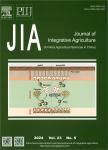Development and identification of Verticillium wilt-resistant upland cotton accessions by pyramiding QTL related to resistance
Development and identification of Verticillium wilt-resistant upland cotton accessions by pyramiding QTL related to resistance作者机构:State Key Laboratory of Crop Genetics & Germplasm Enhancement Ministry of Science and TechnologyHybrid Cotton R&D Engineering Research Center Ministry of EducationCollege of Agriculture Nanjing Agricultural University
出 版 物:《Journal of Integrative Agriculture》 (农业科学学报(英文版))
年 卷 期:2016年第15卷第3期
页 面:512-520页
核心收录:
学科分类:09[农学] 090401[农学-植物病理学] 090402[农学-农业昆虫与害虫防治] 0710[理学-生物学] 0832[工学-食品科学与工程(可授工学、农学学位)] 0830[工学-环境科学与工程(可授工学、理学、农学学位)] 1004[医学-公共卫生与预防医学(可授医学、理学学位)] 0905[农学-畜牧学] 0906[农学-兽医学] 0904[农学-植物保护] 0901[农学-作物学] 0703[理学-化学] 0902[农学-园艺学] 0713[理学-生态学]
基 金:financially supported in part by the National Natural Science Foundation of China (31171590) the National High-Tech R&D Program of China (863 Program, 2012AA101108) the Jiangsu Agriculture Science and Technology Innovation Fund, China (cx(13)3059) a project funded by the Priority Academic Program Development of Jiangsu Higher Education Institutions, China (010-809001) the Jiangsu Collaborative Innovation Center for Modern Crop Production, China (No. 10)
主 题:upland cotton Verticillium wilt resistance pyramiding QTL germplasm enhancement
摘 要:Cotton Verticillium wilt is a serious soil-borne disease that leads to significant losses in fiber yield and quality worldwide. Currently, the most effective way to increase Verticillium wilt resistance is to develop new resistant cotton varieties. Lines 5026 and 60182 are two Verticillium wilt-resistant upland cotton accessions. We previously identified a total of 25 quantitative trait loci(QTLs) related to Verticillium wilt resistance from 5026 and 60182 by assembling segregating populations from hybridization with susceptible parents. In the current study, using 13 microsatellite markers flanking QTLs related to Verticillium wilt resistance, we developed 155 cotton inbred lines by pyramiding different QTLs related to Verticillium wilt resistance from a filial generation produced by crossing 5026 and 60182. By examining each allele's effect and performing multiple comparison analysis, we detected four elite QTLs/alleles(q-5/NAU905-2, q-6/NAU2754-2, q-8/NAU3053-1 and q-13/NAU6598-1) significant for Verticillium wilt resistance, pyramiding these elite alleles increased the disease resistance of inbred lines. Furthermore, we selected 34 elite inbred lines, including five lines simultaneously performing elite fiber quality, high yield and resistance to V. dahliae, 14 lines with elite fiber quality and disease resistance, three lines with high yield and disease resistance, and 12 lines with resistance to V. dahliae. No correlation between Verticillium wilt resistance and fiber quality traits/yield and its components was detected in the 155 developed inbred lines. Our results provide candidate markers for disease resistance for use in marker-assisted breeding(MAS), as well as elite germplasms for improving important agronomic traits via modern cotton breeding.



